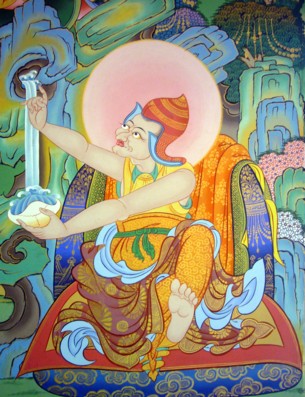Mahayoga: Difference between revisions
No edit summary |
No edit summary |
||
| Line 1: | Line 1: | ||
[[Image:Jnanakumara.JPG|frame|Nyak Jñanakumara]] | |||
'''Mahayoga''' (Skt. ''mahāyoga''; [[Wyl.]] ''rnal 'byor chen po'') — the first of the [[three yanas of powerful transformative methods]] according to the [[nine yanas|nine yana]] classification of the [[Nyingma]] school. | '''Mahayoga''' (Skt. ''mahāyoga''; [[Wyl.]] ''rnal 'byor chen po'') — the first of the [[three yanas of powerful transformative methods]] according to the [[nine yanas|nine yana]] classification of the [[Nyingma]] school. | ||
| Line 23: | Line 24: | ||
==The Lineage of Mahayoga== | ==The Lineage of Mahayoga== | ||
A central figure in the transmission of the Mahayoga | A central figure in the transmission of the Mahayoga tantras was [[King Dza]], who was empowered with their understanding through visions of [[Vajrasattva]] and [[Vajrapani]]. He received the oral transmission from the Vidyadhara Vimalakirti, who had been given the tantric teachings by Vajrapani at Mt. Malaya in Sri Lanka. The lineage passed to the great siddha [[Kukkuraja]], and then via [[Buddhaguhya]] to [[Vimalamitra]] and [[Padmasambhava]], who taught them to their Tibetan disciples. [[Nyak Jñanakumara]] received the transmission of the Mahayoga teachings from both [[Vimalamitra]] and Guru Rinpoche, collaborated in the translation of [[tantra]]s of the ''[[Web of Magical Illusion]]'' and thus played an important role in the early transmission of the mahayoga lineage. | ||
==Notes== | ==Notes== | ||
Revision as of 14:05, 16 March 2010

Mahayoga (Skt. mahāyoga; Wyl. rnal 'byor chen po) — the first of the three yanas of powerful transformative methods according to the nine yana classification of the Nyingma school.
Overview Given by Alak Zenkar Rinpoche[1]
The vehicle of mahayoga, or ‘great yoga,’ is so-called because it is superior to ordinary yoga tantra since all phenomena are realized to be a magical display in which appearance and emptiness are indivisible.
Entry Point
Once one’s mind has been matured through receiving the ten outer benefiting empowerments, the five inner enabling empowerments and the three secret profound empowerments, one keeps the samayas as they are described in the texts.
View
By means of extraordinary lines of reasoning, one establishes and then realizes the indivisibility of the [two] higher levels of reality, according to which the cause for the appearance of the essential nature, the seven riches of the absolute, is spontaneously present within the pure awareness that is beyond conceptual elaboration, and all relative phenomena naturally appear as the mandala of deities of the three seats.
Meditation
When it comes to the path and the practice of meditation, the main emphasis is on the generation stage. In the practice of generation stage yoga, one sets up the practice through the three samadhis, ensures that the three of purifying, perfecting and ripening are complete within the visualization, and, once the visualization is complete, seals it with the instruction on the four nails securing the life-force. In the practice of the completion stage yoga, one activates the vital points of the vajra body, its subtle energies, essences, luminosity and so on.
Conduct
One maintains elaborate, unelaborate and extremely unelaborate conduct.
Results
In the short term one reaches the four vidyadhara levels, which are the results belonging to the path, and finally one gains the ultimate fruition, and reaches the level of the Vajradhara of unity.[2]
Subdivisions
See the two divisions of Mahayoga.
The Lineage of Mahayoga
A central figure in the transmission of the Mahayoga tantras was King Dza, who was empowered with their understanding through visions of Vajrasattva and Vajrapani. He received the oral transmission from the Vidyadhara Vimalakirti, who had been given the tantric teachings by Vajrapani at Mt. Malaya in Sri Lanka. The lineage passed to the great siddha Kukkuraja, and then via Buddhaguhya to Vimalamitra and Padmasambhava, who taught them to their Tibetan disciples. Nyak Jñanakumara received the transmission of the Mahayoga teachings from both Vimalamitra and Guru Rinpoche, collaborated in the translation of tantras of the Web of Magical Illusion and thus played an important role in the early transmission of the mahayoga lineage.
Notes
- ↑ A Brief Presentation of the Nine Yanas by Alak Zenkar Rinpoche
- ↑ ‘Unity’ here means the unity of dharmakaya and rupakaya.
Further Reading
- Tulku Thondup, Masters of Meditation and Miracles, edited by Harold Talbott (Boston: Shambhala, 1999), pages xx-xx.